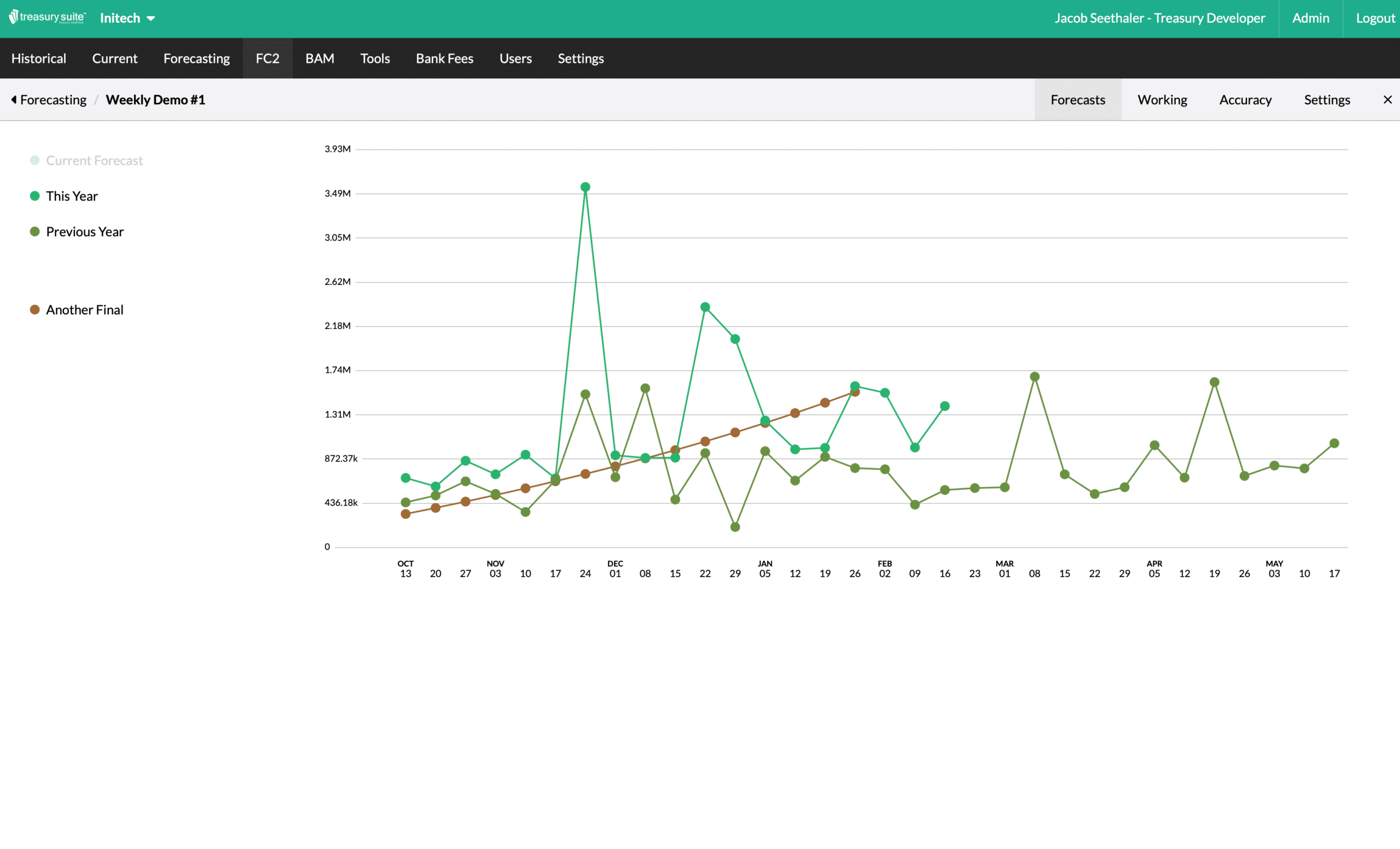Frequently Asked Questions
How can treasury cash forecasting improve liquidity?
Treasury cash forecasting improves liquidity by providing accurate predictions of cash flow, enabling businesses to manage their funds more effectively. This foresight allows for timely investments and reduces the risk of cash shortfalls, ensuring financial stability.
How does cash forecasting reduce financial risk?
Cash forecasting reduces financial risk by providing accurate projections of cash flow, enabling businesses to anticipate shortfalls and make informed decisions. This proactive approach helps mitigate potential liquidity issues and supports strategic financial planning.
What are the common metrics used in treasury cash forecasting models?
The common metrics used in treasury cash forecasting models include cash flow projections, cash conversion cycles, working capital ratios, and liquidity ratios. These metrics help organizations assess their cash position and make informed financial decisions.
What are the key inputs for cash flow forecasting?
The key inputs for cash flow forecasting include historical cash flow data, projected revenues, expected expenses, and timing of cash inflows and outflows. These elements are crucial for creating accurate forecasts that enhance financial decision-making.
What are the benefits of accurate cash forecasting?
The benefits of accurate cash forecasting are significant, as it enhances financial decision-making, improves cash flow management, and enables businesses to anticipate needs, mitigate risks, and seize opportunities effectively.
What are the challenges of treasury cash forecasting?
The challenges of treasury cash forecasting include data accuracy, fluctuating cash flows, and the complexity of integrating multiple financial variables. These factors can hinder effective forecasting, leading to potential cash shortfalls or misallocation of resources.
What is the ideal forecast accuracy for treasury cash?
The ideal forecast accuracy for treasury cash is typically around 90% or higher. Achieving this level of precision enables businesses to make informed financial decisions and effectively manage their cash flow.
Can treasury cash forecasting mitigate financial risks?
Treasury cash forecasting can effectively mitigate financial risks by providing accurate insights into future cash flows. This enables businesses to make informed decisions, anticipate shortfalls, and optimize liquidity, ultimately enhancing overall financial stability.
What is the purpose of treasury cash forecasting be done?
The purpose of treasury cash forecasting is to provide businesses with accurate predictions of their cash flow, enabling better financial planning and decision-making. This process helps optimize liquidity, manage risks, and ensure sufficient funds are available for operational needs.
What are the key benefits of treasury cash forecasting?
The key benefits of treasury cash forecasting are enhanced cash flow management, improved financial decision-making, and the ability to anticipate cash needs, allowing businesses to optimize liquidity and reduce financial risks.
How does cash flow forecasting help manage risk?
Cash flow forecasting helps manage risk by providing businesses with visibility into their future cash positions, enabling proactive decision-making. This foresight allows organizations to identify potential shortfalls and adjust strategies to mitigate financial uncertainties effectively.
What is the impact of cash flow forecasting on liquidity?
The impact of cash flow forecasting on liquidity is significant. Accurate forecasting enhances a company's ability to manage cash reserves effectively, ensuring sufficient liquidity to meet obligations and seize growth opportunities.
What data is required for effective treasury cash forecasting?
Effective treasury cash forecasting requires accurate data on historical cash flows, projected revenues, expenses, and any upcoming financial obligations. This information enables precise forecasting and informed financial decision-making.
What are the common cash forecasting methods used?
The common cash forecasting methods used include the direct method, which analyzes cash inflows and outflows, and the indirect method, which adjusts net income for non-cash transactions. Other techniques involve trend analysis and statistical forecasting for accuracy.
How does cash forecasting improve liquidity management?
Cash forecasting improves liquidity management by providing accurate predictions of cash flow, enabling businesses to anticipate funding needs, optimize cash reserves, and make informed financial decisions. This proactive approach enhances overall financial stability and operational efficiency.
How does treasury cash forecasting affect financial planning?
Treasury cash forecasting significantly impacts financial planning by providing accurate insights into future cash flows. This enables businesses to make informed decisions, allocate resources effectively, and mitigate risks associated with cash shortages or surpluses.
What is the role of forecasting in treasury management?
The role of forecasting in treasury management is to provide accurate predictions of cash flows, enabling businesses to make informed financial decisions, optimize liquidity, and effectively manage risks associated with cash availability.
What is the importance of cash forecasting in treasury management?
The importance of cash forecasting in treasury management lies in its ability to enhance liquidity planning, optimize cash flow, and support informed financial decision-making. Accurate forecasts enable organizations to anticipate cash needs, mitigate risks, and maximize investment opportunities.
What is the purpose of treasury cash flow forecasting?
The purpose of treasury cash flow forecasting is to provide businesses with accurate predictions of future cash inflows and outflows, enabling better financial planning, improved liquidity management, and informed decision-making to optimize cash flow.
What are the challenges of implementing cash forecasting?
The challenges of implementing cash forecasting include data accuracy, integrating multiple data sources, and adapting to changing market conditions, which can complicate the forecasting process and hinder effective cash flow management.
How can forecasting enhance cash management strategies?
Forecasting enhances cash management strategies by providing accurate predictions of cash flow, enabling businesses to make informed decisions, optimize liquidity, and effectively plan for future financial needs. This proactive approach minimizes risks and maximizes financial efficiency.
What tools optimize treasury cash forecasting processes?
The tools that optimize treasury cash forecasting processes include advanced software solutions that provide real-time insights, automated data analysis, and scenario planning capabilities, enabling businesses to enhance their cash flow management and make informed financial decisions.
What factors influence cash flow forecasting accuracy?
The factors that influence cash flow forecasting accuracy include historical data reliability, market conditions, timing of cash flows, and assumptions made during the forecasting process. Accurate inputs and real-time insights enhance the precision of cash flow predictions.
How frequently should cash forecasts be reviewed?
Cash forecasts should be reviewed regularly to ensure accuracy and relevance. Ideally, businesses should assess their forecasts at least monthly, or more frequently if there are significant changes in cash flow or market conditions.
What scenarios should be considered in forecasting?
The scenarios to consider in forecasting include market trends, economic conditions, seasonal fluctuations, and potential disruptions. Analyzing these factors helps create accurate cash flow predictions and informs strategic financial planning.
How does technology improve cash forecasting efficiency?
Technology improves cash forecasting efficiency by providing real-time data analysis, automating routine tasks, and enabling scenario planning. These capabilities allow businesses to make informed financial decisions quickly and accurately, enhancing overall cash flow management.
What are best practices for cash forecasting accuracy?
Best practices for cash forecasting accuracy include utilizing real-time data, regularly updating forecasts, incorporating historical trends, and employing scenario analysis to account for uncertainties. These strategies enhance the reliability of cash flow predictions, supporting informed financial decisions.
How can businesses adapt to cash flow fluctuations?
Businesses can adapt to cash flow fluctuations by implementing robust forecasting tools, maintaining flexible budgets, and establishing a reserve fund to manage unexpected changes. These strategies enhance financial resilience and support informed decision-making.
What role does data analysis play in forecasting?
The role of data analysis in forecasting is crucial. It enables businesses to interpret historical data, identify trends, and make informed predictions about future cash flows, ultimately enhancing decision-making and optimizing financial management.
How can forecasting support investment decision-making?
Forecasting supports investment decision-making by providing accurate predictions of cash flow, enabling businesses to allocate resources effectively, assess potential risks, and identify profitable opportunities, ultimately leading to more informed and strategic financial choices.





